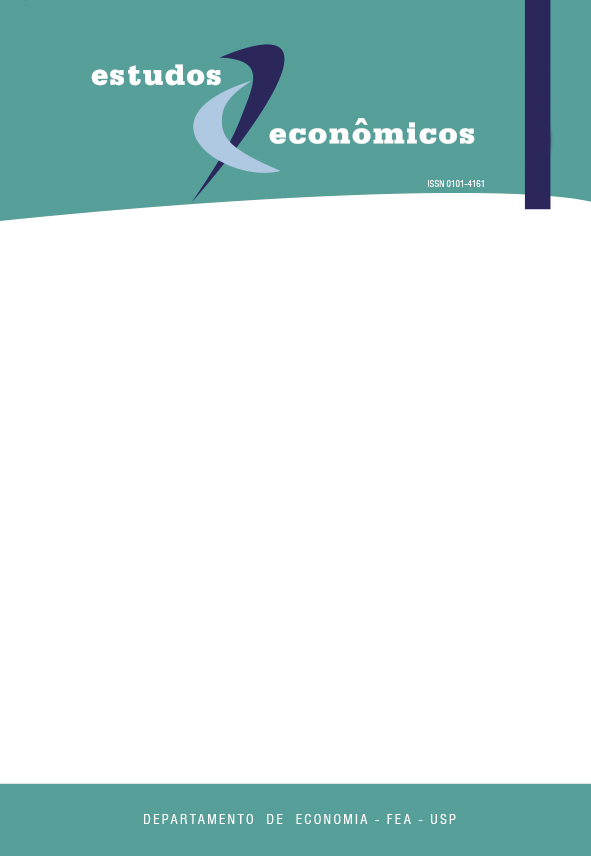Sem medo de flutuar? O regime cambial brasileiro pós-1998
DOI:
https://doi.org/10.1590/S0101-41612005000300005Keywords:
exchange rate arrangements, floating exchange rate, fear of floating, Brazilian exchange rate regimeAbstract
The aim of this paper is to assess the exchange rate arrangement adopted in Brazil since January 1999. We use indicators of the Calvo-Reinhart type to evaluate if the monetary authorities in this country show fear of floating as compared to the cases of a number of other emerging economies as well as developed economies. Our results indicate that the Brazilian authorities intervene more intensively in the foreign exchange market than free floaters do. On the other hand, we can show, through an analysis period by period, that in the absence of strong external shocks, the Brazilian exchange rate arrangement looks like a pure floating one. Moreover, the empirical evidence suggests that monetary authorities seems to be more concerned about a large misalignment of the real exchange rate, than about volatility.Downloads
References
BANCO CENTRAL DO BRASIL. Análise do mercado de câmbio, relatório trimestral.
Jan-mar de 1999. Disponível em http://www.bcb.gov.br/?RELCAMBIO.
BANCO CENTRAL DO BRASIL. Atas da 57ª reunião do COPOM. Disponível em http://www.bcb.gov.br/?COPOM57.
CALVO, G. A.; REINHART, C. M. Fear of floating. NBER Working Paper, n.7993, 2000.
EICHENGREEN, B. International monetary arrangements for the 21st century. Washington
D.C.: Brookings Institution, 1994.
EICHENGREEN, B. Can emerging markets float? Should they inflation target? Banco Central
do Brasil, Working Paper 36, 2002.
EICHENGREEN, B., HAUSMANN, R.; PANIZZA, U. Original sin: the pain, the mystery and the road to redemption. Inter-American Development Bank,
Conference on Currency and Maturity Matchmaking: Redeeming Debt from Original Sin, 2002.
FISCHER, S. Exchange rate regimes: is the bipolar view correct? Disponível em: http://
www.imf.org/external/np/speeches/2001/010601a.pdf , 2001.
FRANKEL, J. A.; DOMINGUEZ, K. Does foreign exchange intervention work? Washington D.C.: Institute for International Economics, 1993.
FRANKEL, J. A. No single currency regime is right for all countries or at all times. NBER Working Paper, n. 7338, 1999.
FMI. Annual report on exchange arrangements and exchange restrictions. 1999.
GOLDFAJN, I.; OLIVARES, G. Can flexible exchange rates still ‘work’ in financially
open economies? G-24 Discussion Paper, n. 8, 2001.
GOLDFAJN, I.; WERLANG, S. The pass-through from depreciation to inflation:
a panel study. Departamento de Economia, PUC-Rio, Working Paper, n. 423, 2000.
GOLDSTEIN, M. Managed floating plus. Institute for International Economics, 2002.
HAUSMANN, R.; PANIZZA, U.; STEIN, E. Why do countries float the way they
float? Inter-American Development Bank, Working Paper 418, 2000.
HAUSMANN, R.; GAVIN, M.; LEIDERMAN, L. The macroeconomics of capital flows to Latin America: experience and policy issues. Inter-American Development Bank, Working Paper 310, 1995.
KENEN, P. Daily dollar sales and beyond. Nota técnica do Banco Central do Brasil, n. 9, 2001.
McKINNON, R.; SCHNABL, G. The East Asian dollar standard, fear of floating,
and original sin. Disponível em: http://www.stanford.edu/~mckinnon/papers.htm, 2003.
MUSSA, M. et al. Exchange rate regimes in a increasingly integrated world economy.
Washington, D.C.: IMF Occasional Paper, 2000.
REINHART, C. M. The mirage of floating exchange rates. American Economic Review, v. 90, n. 2, p. 65-70, 2000.
SILVEIRA, M. A. C. da. Intervenção da autoridade monetária no mercado de câmbio em regime de flutuação administrada. Nota técnica do Banco Central do Brasil, nº 34, 2003.
STURZENEGGER, F.; LEVY-YEYATI, E. Classifying exchange rate regimes: deeds vs words. Universidad Torcuato Di Tella, 2002.
WILLIAMSON, J. Exchange rate regimes for emerging markets: reviving the intermediate
option. Washington, D.C.: Institute for International Economics, 2000.
Downloads
Published
Issue
Section
License
Copyright (c) 2005 Francisco Eduardo Pires de Souza

This work is licensed under a Creative Commons Attribution-NonCommercial 4.0 International License.
By submitting an article, the author authorizes its publication and attests that it has not been submitted to any other journal. The original article is considered final. Articles selected for publication are proofread for grammatical and orthographic errors. The journal does not pay rights for published articles. The Institute of Economic Research from the School of Economics, Business and Accounting of the University of São Paulo (Instituto de Pesquisas Econômicas da Faculdade de Economia, Administração e Contabilidade da Universidade de São Paulo) owns the journal's copyright.




